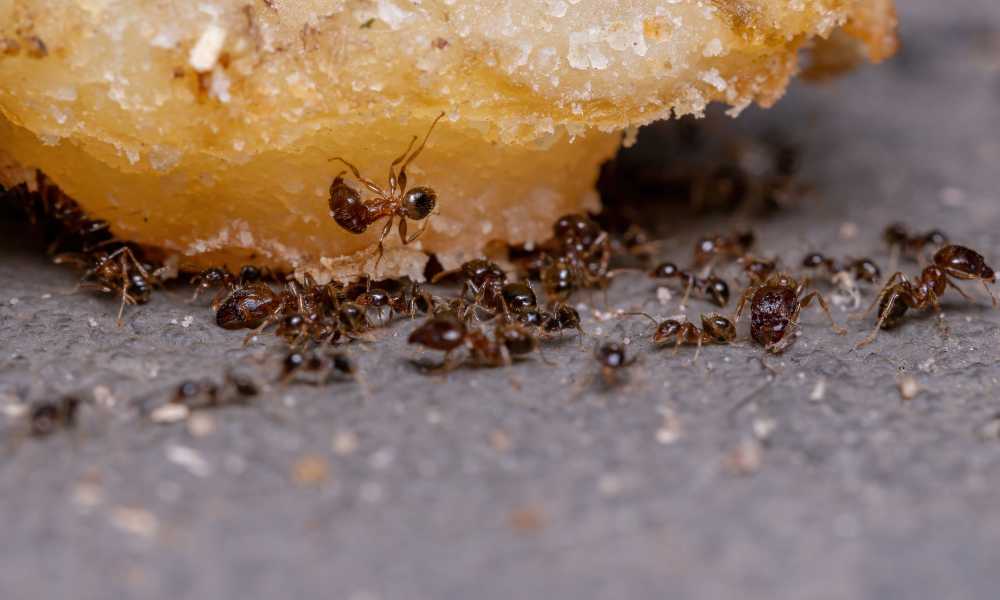Small black ants in the kitchen are a common nuisance faced by homeowners, often infiltrating the space in search of food and water sources. These tiny invaders, though seemingly harmless, can quickly become a major annoyance if not addressed promptly. Their presence not only compromises the cleanliness of the kitchen but also poses potential health risks, as they can contaminate food supplies. Addressing this issue promptly is crucial to prevent a minor inconvenience from escalating into a more significant and challenging problem. In this guide, we will explore effective strategies to eliminate and prevent the recurrence of small black ants in the kitchen, ensuring a clean and pest-free environment.
Identification of Small Black Ants

Physical Characteristics
Small black ants typically measure between 1/16 to 1/8 inch in length, with dark-colored bodies and distinct body segments. Their antennae are bent, and they have a distinctive appearance that sets them apart from other ant species.
Behavior Patterns in the Kitchen
Small black ants are known for their persistent foraging behavior in search of food. They often form visible trails, navigating across countertops, floors, and pantry shelves. Understanding their movement patterns is crucial in devising effective strategies for control and prevention.
Understanding the Attraction

Common Food Sources that Attract Small Black Ants
Small black ants are particularly attracted to sugary substances, crumbs, and food residue. Understanding their dietary preferences is essential for implementing targeted measures to eliminate these food sources and discourage their presence.
Environmental Factors Contributing to Infestation
Certain environmental conditions can contribute to ant infestations. Factors such as moisture, unsealed entry points, and favorable nesting sites play a role in encouraging ant colonies to establish themselves in kitchen spaces. Identifying and addressing these contributing factors is vital for long-term ant control.
Prevention Strategies

Proper Food Storage
Implementing secure food storage practices is key to denying small black ants access to their primary food sources. Seal food items in airtight containers to eliminate attractive scents and prevent infestations.
Regular Cleaning Routines
Maintaining a clean and clutter-free kitchen is essential for deterring ants. Regularly sweep, mop, and wipe down surfaces to eliminate crumbs and spills that may attract and sustain ant colonies.
Sealing Entry Points
Identify and seal potential entry points such as cracks, gaps, or openings in walls, windows, and doors. By blocking these access routes, you can significantly reduce the chances of ants infiltrating the kitchen.
Removing Standing Water
Addressing any sources of standing water in the kitchen is crucial, as ants are attracted to moisture. Fix leaks promptly, keep sinks dry, and ensure proper drainage to eliminate water reservoirs that may entice ants.
Natural Remedies

Use of Vinegar and Water Solution
Create a solution of equal parts vinegar and water to clean surfaces and areas frequented by ants. The strong scent of vinegar disrupts their pheromone trails, discouraging their presence in the treated areas.
Citrus Peels as a Deterrent
Place citrus peels, such as those from lemons or oranges, near entry points and ant trails. The natural oils in citrus peels act as a deterrent, making the area less appealing for ants.
Essential Oils with Ant-Repelling Properties
Utilize essential oils like peppermint, cinnamon, or tea tree oil, known for their ant-repelling properties. Mix a few drops with water and spray the solution in areas prone to ant activity for a natural and aromatic deterrent.
Chemical Solutions
Overview of Ant Baits
Ant baits are an effective chemical solution for controlling small black ants in the kitchen. These baits typically contain a slow-acting insecticide mixed with an attractive substance that lures ants. The foraging ants carry the bait back to the colony, leading to the gradual elimination of the entire ant population. Place baits strategically along ant trails and near entry points to maximize their effectiveness.
Insecticidal Sprays and Their Application
Insecticidal sprays formulated specifically for ants can provide immediate relief from infestations. When using these sprays, apply them directly to ant trails, nests, and areas with high ant activity. It’s essential to follow product instructions carefully and target the spray to minimize environmental impact while maximizing its efficacy.
Considerations for Safe and Effective Use
When using chemical solutions, prioritize safety for both residents and pets. Read and adhere to the instructions on the product labels, wearing protective gear if necessary. Keep treated areas well-ventilated and restrict access until the recommended drying time has elapsed. Additionally, consider environmentally friendly or low-toxicity options to minimize the impact on non-target organisms.
Professional Pest Control
When to Seek Professional Assistance
Certain infestations may be beyond the scope of DIY solutions, warranting the need for professional pest control. Signs such as persistent ant activity despite preventive measures, large colonies, or a recurrence of the infestation may indicate the necessity of expert intervention.
Hiring a Pest Control Service
When opting for professional assistance, choose a reputable pest control service with experience in ant removal. The service provider will conduct a thorough inspection to identify the extent of the infestation, implement targeted treatments, and provide recommendations for ongoing prevention. Ensure the chosen service follows ethical and environmentally responsible practices.
Long-Term Prevention After Professional Intervention
Following professional pest control, focus on maintaining a proactive approach to prevent future infestations. Implement the preventive strategies outlined earlier, such as proper food storage, regular cleaning, and sealing entry points. Regular inspections can help catch potential issues early, and incorporating natural remedies as ongoing deterrents can contribute to a sustained pest-free environment. Balancing the use of chemicals with environmentally friendly practices ensures a safe and sustainable approach to pest management.
Maintaining a Pest-Free Kitchen
Regular Inspections and Monitoring
Conduct periodic inspections of the kitchen and surrounding areas to identify any signs of ant activity or potential entry points. Monitor for ant trails, nests, and changes in behavior. Early detection allows for prompt intervention, preventing a minor issue from developing into a full-blown infestation.
Adapting and Reinforcing Prevention Strategies
Recognize that prevention is an ongoing process. As seasons change or environmental conditions fluctuate, adapt prevention strategies accordingly. Stay vigilant in maintaining proper food storage, cleanliness, and sealing entry points. Regularly assess the effectiveness of natural remedies and chemical solutions, making adjustments as needed.
Educating Household Members on Ant Prevention
Foster a shared responsibility among household members by educating them on ant prevention measures. Encourage everyone to contribute to a pest-free environment by adhering to proper food storage practices, promptly cleaning up spills, and being mindful of maintaining a clean kitchen space. Awareness and collaboration are key components of successful, long-term pest management.
Conclusion
Successfully addressing and preventing small black ants in the kitchen requires a multifaceted approach. Initiating preventive measures, such as proper food storage and regular cleaning, forms the foundation. Natural remedies and chemical solutions offer effective means of control when implemented judiciously. To maintain a pest-free kitchen, ongoing efforts are necessary, including regular inspections, adaptability in prevention strategies, and fostering a household-wide commitment to ant prevention. By combining these elements, homeowners can enjoy a clean, safe, and pest-free kitchen environment. Remember, persistence and consistency in preventive measures are key to long-term success in managing small black ant infestations.




